A study into conditions for the poor in the nineteenth century
In 2018 the Modern Records Centre acquired a series of pamphletsLink opens in a new window which had been collected by the 19th century clergyman and social reformer Reverend Brooke Lambert. The first researcher to examine them was Miša Hennin, History undergraduate at the University of Warwick, who has written this examination of some of the sources during her placement at the MRC.
The photograph of Rev. Brooke Lambert has been reproduced with permission of St George-in-the-East Church, WhitechapelLink opens in a new window.
Who was Reverend Brooke Lambert?

Brooke Lambert was a vicar born in Surrey in the nineteenth century. He studied at King’s College in London and at Oxford before becoming the vicar of St Mark’s in Whitechapel where he performed duties outside of his role. Lambert conducted studies of poor law administration and more broadly of living conditions for the poorer classes. He engaged in much voluntary work and set up support systems for the impoverished, for example, a soup kitchen.
Why Brooke Lambert?
Henry Solly called Lambert both a ‘true Christian clergyman’ and a ‘genuine social reformer’ 1 for his work in poverty. Whilst this shows contemporary nineteenth century acknowledgement for Lambert’s efforts, such attitudes were not the norm. Conditions, especially in big centres such as London, were dire for the lower classes, yet legislation to protect the poor was insufficient. The work on behalf of individuals therefore proved important to the lives of many, and these figures deserve acknowledgement and appreciation for the work they conducted of their own accord, outside of state campaigns.
The sources consulted in preparation for this project were found in pamphlets collected by LambertLink opens in a new window alongside his own writing.
Infant Mortality
A crucial issue plaguing nineteenth century British society was the high rate of infant mortality. Death rates amongst the wider population were high, particularly by today’s standards, however the concerning figures lay within the death of children. In 1857 the Registrar-General reported the number of deaths of children under the age of one, giving formal recognition to the frightening statistics.
From 1876 to 1899 birth rate fell by 14%, whilst infant mortality rose by 7%. Towards the end of the century infant welfare provision began to be considered by the government due to concerns about how population strength reflects on imperial power. Notions of imperialism with regard to the health of infants were epitomised in the general belief that children belonged ‘not merely to the parents but to the community as a whole,’ they were a ‘national asset’, on them depended ‘the future of the country and the empire’. Some districts began to distribute leaflets on infant care but government legislation was not brought in until the twentieth century 2.
Within Lambert’s collection is a pamphlet titled Infant Mortality: Its Causes and RemediesLink opens in a new window, published in 1871. The source describes reasons for objection to the proposal of an Infant Life Protection Bill, inspired by the fact that ‘nearly half of all the children born die under five years of age’. A key point in the objection, is that the Bill ‘aims at removing the apparent and proximate causes’ of mortality, whilst ‘it leaves the real and ultimate causes untouched’. The primary cause the objection attributes to infant mortality is the ‘ignorance and poverty of women’, which is due to the inadequate education and training they receive. The text explains that ‘ignorance and poverty are usually either the causes or the conditions of the sin of which infanticide and baby farming proper are the results’. This fascinating phenomenon of blaming mothers prevailed for many decades, leading to the growth of schools for mothers, to instruct them in what they were destined to do, and the publishing of a plethora of advice literature. Working-class mothers were particularly targeted by accusations of ignorance, and these prejudices were exemplified by women’s necessity to work during pregnancy or after childhood, which was believed to result in higher infant mortality. Such issues were addressed through leaflets, lectures and visitations from the nineteenth century way into the twentieth.
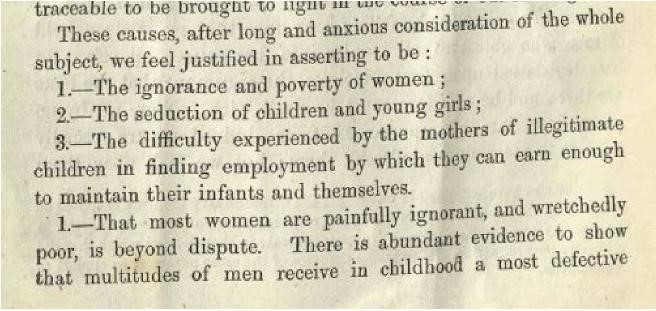
Education of children
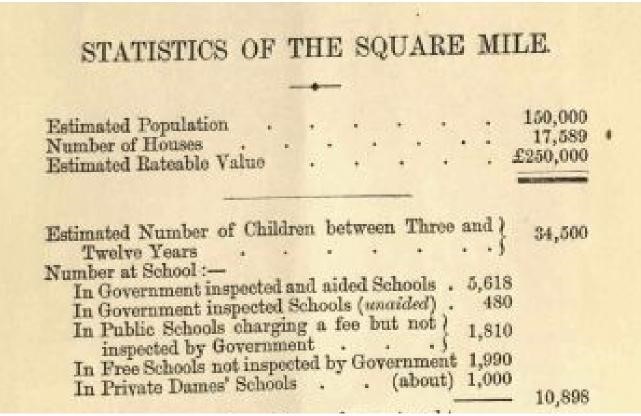
In chronological progression, the next important epoch sees the education of slightly older children. However, due to poverty and living conditions many children did not attend school, and consequently never received the education which could potentially move them up into a better social sphere. Published in 1870 by George Bartley the Educational Condition and Requirements of One Square Mile in the East-End of LondonLink opens in a new window, considers issues of education. The pamphlet claims a figure of 34,500 children between three and twelve years, 10,898 of whom attend school, leaving 23,602 ‘growing up more or less in ignorance’. Crucially, the two causes of such absence fall within blame of the parents. Firstly, the ‘apathy and indifference of parents’ is described, and secondly, and perhaps more devastatingly, ‘the early age at which children are employed in assisting their parents’. The pamphlet acknowledges how widespread this second issue is, affecting children in ‘thousands of cases’. Bartley explains that ‘children are required by their parents to work in aid of the general fund at a very tender age’; children are employed as ‘match-box makers, penny toy makers, weavers’ before the age of ten, jeopardising both their education and their experience of childhood. Furthermore, a small fee was required by many schools which families did not feel they could afford; costs mixed with the apathy mentioned above offered the clear answer for parents to not insist on schooling.
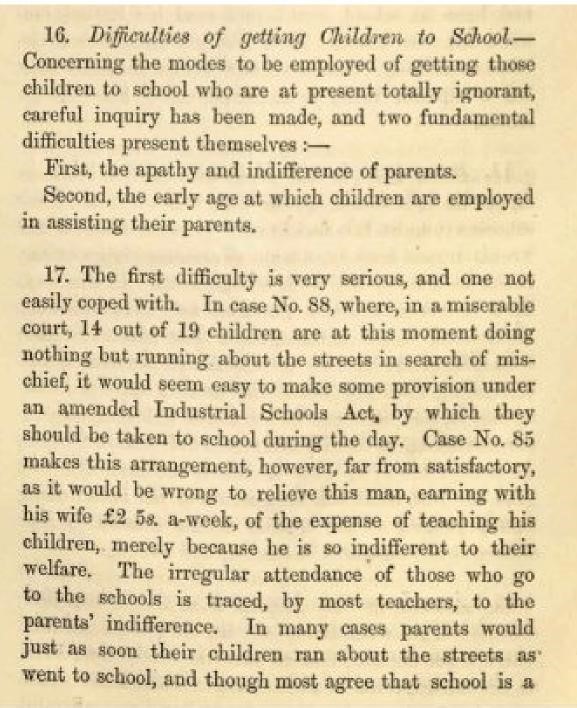
Bartley suggests that the lack of legislation is to blame for this immoral use of children, explaining that ‘as long as employers are allowed to do pretty much as they like, it is impossible for parents...to resist the temptation of sending their children out to work’. A particularly extreme case identified by Bartley describes a child of four years old working ‘at filling his father’s match-boxes.’ Other cases worth mentioning with the intention of depicting conditions of living are as follows:
- ‘A respectable family, though extremely poor.’ Two of four children attend school; one is kept at home to avoid the fee, and the fourth boy works. The children all had small-pox which ‘reduced the finances of the family considerably’, emphasising the important connection between disease and poverty.
- A family of six children in a ‘very dirty, almost filthy room, serving as bed-room, parlous and all.’ One of the six children went to school, but the parents cannot afford to send the others.
- ‘A respectable family, though wretchedly dirty and untidy.’ Nine of thirteen children were living and all had been to school. ‘The house was dirty and miserably untidy, and the general style of the place was very bad’
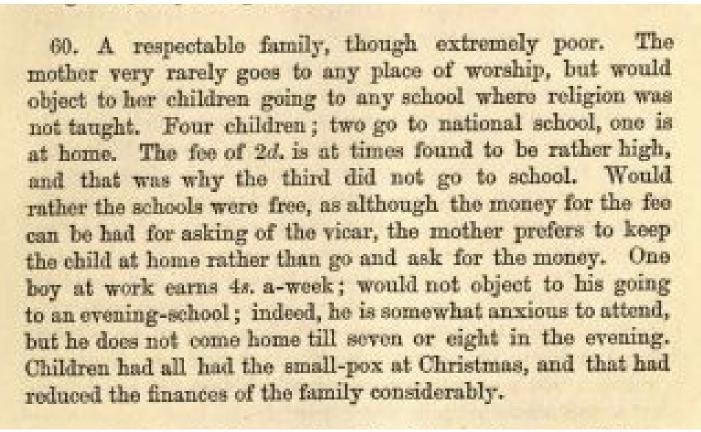
Reading such accounts was particularly interesting due to their relation to stories I have heard from my grandfather. His own father died when my grandad was around ten years old, leaving responsibility for rearing and providing to his mother. My grandad was the eldest of four; consequently, by the age of thirteen he had to leave school to help provide for the family. He worked in a butchers shop and stayed within the industry for the next thirty years. It is hard to imagine how desperate financial situations would have to get for parents to send children so young to work; therefore, the cases described help to emphasise the extreme neglect faced by lower-class families.
General living conditions
Expanding now to consider wider living conditions, sources of sanitary conditions from both the Whitechapel district and Liverpool will be considered, in order to emphasise the national spread of such issues, highlighting that they were not limited only to a particular region. In the 1866 sourceLink opens in a new window, cases of smallpox, diarrhoea and fever increased considerably, from 6 to 41, from 119 to 261,and from 89 to 100 respectively, from the previous year. Additionally, much attention is paid to the issue of overcrowding. The report emphasises that ‘the danger to the public health from overcrowding is very great’; however, interestingly, a big focus is placed not on the risk to physical health, but the risk to morality which ‘this evil’ poses. Cases of ‘gross immorality’ describe ‘adult brothers and sisters, fathers and adult daughters, mothers and adult sons, uncles and nieces, sleeping together in the same room’.

The March 1867 Whitechapel reportLink opens in a new window similarly begins with mortality statistics, emphasising the horror of diseases and epidemics. However, the most interesting issue reported, is the ‘three cases of a prolonged retention of a body in the room occupied by a family as a living and sleeping arrangement.’ In the first case, ‘the corpse of a man was kept for 9 days,’ in the second, ‘the corpse of a youth who had died from fever was kept for 10 days’, and in the final case, a male corpse was kept for 21 days. The inspector notes that such cases have occurred over the last ten years, and suggests that the lack of ‘proper places...provided for this purpose’ is to blame. The threat of the keeping of a diseased body on inhabitants of the room is highlighted.
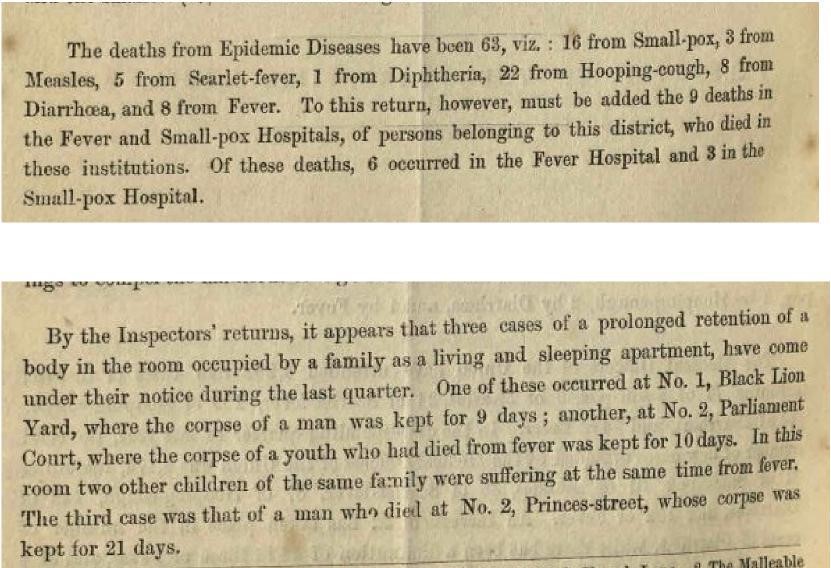
This report highlights another common issue. Many landlords ‘in order to economise space, have built houses without having provided them with back yards, in which a privy for the use of the inhabitants of each house ought to have been placed.’ In such houses, privies were placed in ‘the open space in front of the houses’, meaning they are ‘accessible to the public’ and a ‘constant source of nuisance.’ In addition to the nuisance of public use, they are also ‘not properly constructed’, and ‘they are not in sufficient number for the use of the tenants,’ and finally, ‘they are not provided with seats for children.’ As a consequence of these conditions, ‘the floor of the privies is covered with filth, or the court itself is more or less covered with human excrement to the annoyance of the inhabitants’. This paints quite a dire picture of life in London.
Finally, in addressing sanitary condition, there is a section devoted to trade discontent. Here ‘proceedings against Mr. Quaintrall’ are presented. His business is ‘Bone-Boiler and Bone-Crusher’, and the nuisance is ‘caused by the prolonged retention of bones on his premises’. The ‘disgusting and health-destroying nuisance’ is intensified by Mr. Quaintrall’s poor maintenance of the building.
In the June 1867 Whitechapel Sanitary reportLink opens in a new window, whilst discussing death from disease, the inspector addresses the issues of ‘bad air, overcrowding, insufficient food and clothing’, and the main cause of infant mortality is ‘considered to be a test of the insalubrity of a district’, reinforcing the notions of ignorance discussed above.
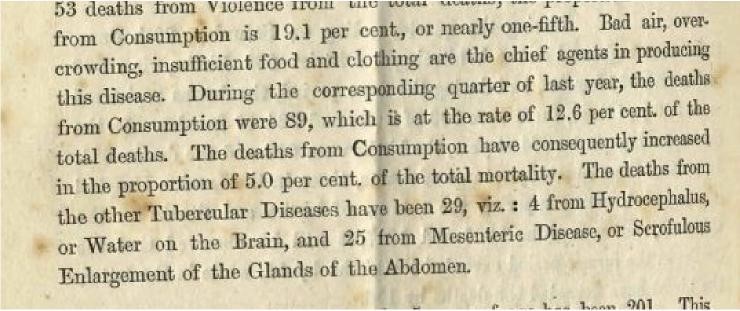
This report similarly refers to the retention of dead bodies, but describes a case in more detail. ‘The room was occupied by a family of 7 persons...and had a cubic space of only 1536 feet, affording an average space to each person of 219 cubic feet’. The inspector urged the family to remove the dead body, but ‘they said that they could not do so, and the result was that the burial did not take place for two days after, when the body became a disgusting nuisance’. The inspector demanded the purification of the room. The cause of this practice amongst certain families is that ‘the few existing dead houses in the district are all too small for the purposes intended by the Act’.
Moving on to conditions in Liverpool in 1871Link opens in a new window, the focus is primarily on sewage and drainage issues and debates regarding the most appropriate methods of conducting these processes. Concern over noxious gases is expressed, with an argument that sleeping within such fumes will inevitably lead to disease. The author writes, ‘it is utterly impossible to send millions of tons of decomposing matter, even into so large a river as the Mersey, without extreme and permanent danger to the public health. You are polluting the shores with filth, you are wasting the food resources of the nation.’ Sewage is also considered extensively in the London sources, emphasising the reach of this issue.
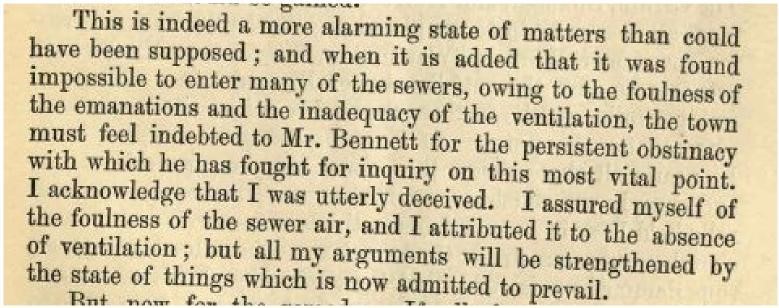
General Mortality
Finally, turning to the last stages of life, the Daily Return of Births and Deaths in London from 1866Link opens in a new window will be addressed. Immediately, the overwhelming variety and prevalence of disease is apparent. From the West Districts the following causes are identified:
- Diarrhoea (5)
- Marasmus (2)
- Typhus (1)
- Catarrh (1)
- Bronchitic (5)
- Carcinomatous disease (1)
- Intussusception (1)
- Pulmonitis (3)
- Enteritis (1)
- Scarlatina (2)
- Pertussis (2)
- Convulsions (3)
- Cancer (1)
- Aptha (1)
- Phthisis (1)
- Smallpox (1)
- Gastroenteritis (1)
- Want of breast-milk (3)
- Scarlet fever (1)
- Debility from birth (1)
- Fatal fainting (1)
- Asphyxia (1)
Diarrhoea, marasmus, typhus, bronchitis, enteritis amongst many others have preventable causes and can be considered unnecessary deaths. Causes include being bitten by fleas or rats, or infections, or breathing polluted air, all of which we consider emblematic of lower-class living conditions in this era. Infectious diseases were particularly rife and in the 1860s John Simon called for a system of notification and isolation for patients of infectious diseases. By 1883, 34 towns had set up infectious disease hospitals and in 1889 notification of infectious disease became compulsory in London, though remained optional elsewhere. Hence, towards the end of the century, there was an increasing understanding of disease and of preventability.
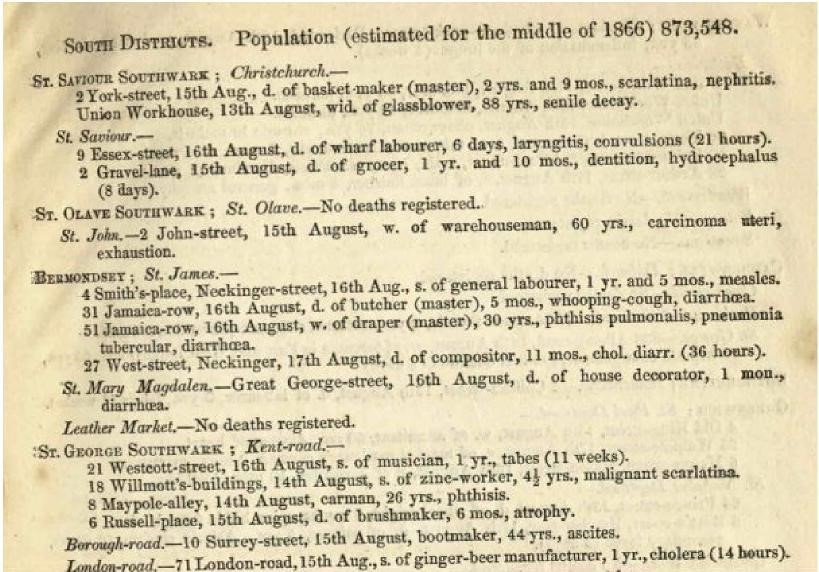
Reflection
The greatest issue in conducting this project was the wealth of sources available to me. With my first visit to the Modern Records Centre I was overwhelmed, even after having narrowed my point of interest to social history rather than political, religious or economic. As well as the mass of sources available to me, the perspectives from which I could choose to study them was broad. I had to ask myself what issues did I want to address, what did I want to be evident from my study. With such a lot to consider, my first few visits involved general research with the hope of getting a grasp of the material before me. My interest lay in social history, particularly for the poor population; however, despite knowing this, it was still difficult to identify a specific point of focus. Liz helped a lot by talking through my ideas with me, and she suggested I take a look at Reverend Brooke Lambert, who I had not heard of prior to this. Online research made me aware of his exceptional efforts to improve conditions for the poor, and I was happy to learn that the MRC had his personal collection of pamphlets and research. It was fascinating to see how his research was conducted, information collated and to learn what he considered important or relevant. Progress from that point was still difficult though, because despite Lambert’s research fitting into two boxes, the density of each text was immense. I had several different ideas throughout the course of my study, changing my focus a number of times, but finally settled on the broad topic of conditions of the poor. Under the advice of Liz, I decided to choose a select few sources, read them and then compile them into a case study. The reading I found interesting, particularly the more personal descriptions of individual family circumstances.
1 Henry Solly, 'These Eighty Years': Or, The Story of an Unfinished Life , p. 554
2 Anna Davin, Imperialism and Motherhood, p. 10
